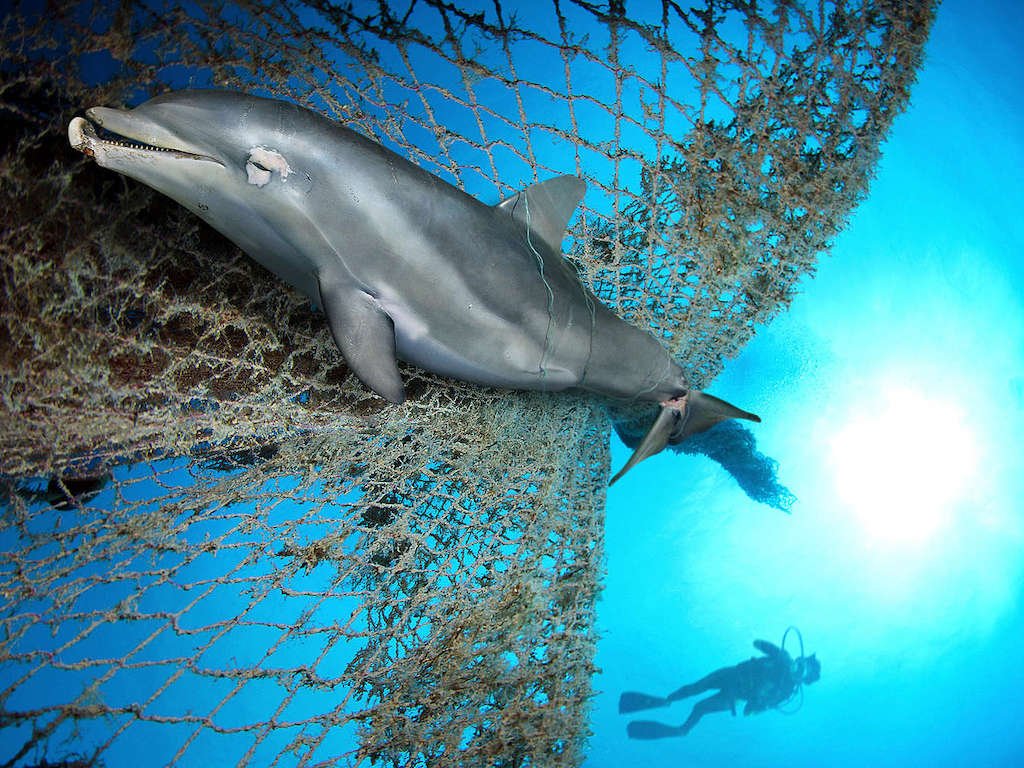
Fishing
According to the FAO, nearly 90% of the world’s marine fish population groups are now exploited so significantly that populations of targeted species are unable to replenish at the rate they are being fished, with some in serious decline. Some populations, including Bluefin tuna, Atlantic halibut, Atlantic cod, Atlantic salmon, red snapper and yellowfin tuna, have been pushed to the brink of extinction. Over-fishing is one of the biggest dangers facing our oceans, threatening ocean ecosystems.
Commercial fishing impacts the wider ocean ecosystem, competing with higher order predators for available food sources, causing habitat destruction through fishing methods and killing a huge number of non-target species, commonly referred to as by-catch.
In addition to the wild-caught fishing industry, Australia also has numerous intensive fish farms across the country, which grow fish on land in large tanks, or out at sea in cages. Though this is often promoted as a solution to reducing the fishing industry's impacts on our oceans, fish farming comes with a plethora of damaging environmental consequences too.
Wild-caught fish
The industrialised fishing industry is notoriously unsustainable, overfishing our oceans to meet an ever increasing global demand for seafood. The fishing vessels deployed by the fishing industry can be over 30 metres in length, with the capacity to catch hundreds of tonnes of fish every day. The sheer ability of the fishing industry to capture so many fish each day makes it a massive driver in the decline of oceanic wildlife.
Many practices adopted by the fishing industry pose a danger to ocean environments. Trawling is a common practice that involves dragging weighted nets along the ocean floor to capture all the creatures in its path. This disrupts and erodes the bottom of the seabed and frequently drags up plants and coral populations that are of vital importance in maintaining the balance of marine ecosystems. According to the United Nations, 95% of worldwide ocean damage is directly linked to bottom trawling.
Littering our oceans
Lost and abandoned fishing gear is another grave concern associated with the fishing industry. One Greenpeace report found that 640,000 tonnes of waste in our oceans each year is abandoned or lost fishing gear. Fishing gear is particularly concerning to oceanic ecosystems, because it is specifically designed to capture marine animals. Many species including whales, seals, turtles and sharks become entangled or caught by discarded fishing gear, leaving them to die a slow and agonising death. A single ghost fishing net killed approximately 300 sea turtles in Mexican waters in 2018. It is estimated that more than 650,000 marine mammals, including dolphins, whales, seals are killed or injured in fishing nets each year.
By-catch; threatening
non-target species
One of the biggest threats posed by the commercial fishing industry to the ocean ecosystem is by-catch, which refers to the non-targeted species unintentionally caught and killed by fishing nets and lines. All forms of commercial fishing are indiscriminate and have a destructive impact upon the wider ecosystem, with some estimates suggesting 20 million non-target individuals are killed by the fishing industry every year.
Moving forward
Explore some of the solutions available to the current issues facing our marine environment on the previous page.
Join the Wildlife Protection Commitment
For socially responsible brands, businesses and institutions looking to reduce their impact on native wildlife.

Stay up to date with us
Receive email updates on the progress of Defend the Wild and our latest campaigns by signing up to our mailing list.





